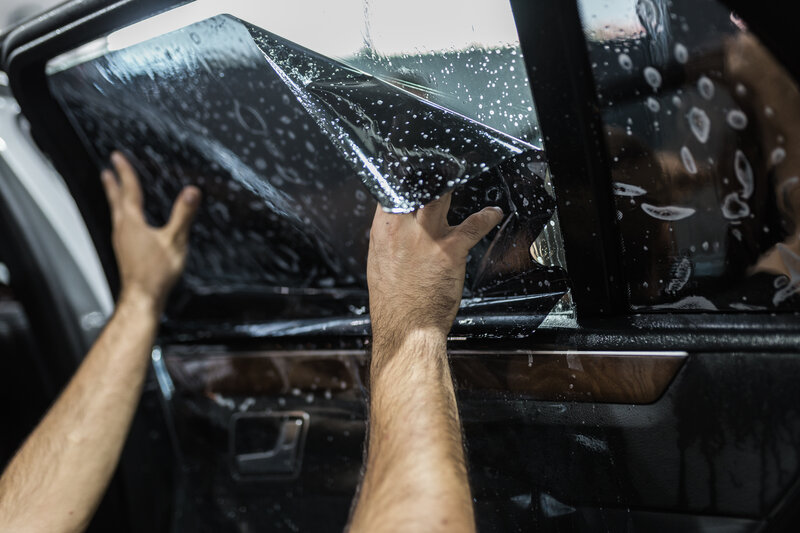The Refine of Expert Window Tinting Explained
From choosing the right film kind to the meticulous preparation of windows, each step plays an important function in achieving a flawless application. Complying with these first preparations, the cautious cutting and application of the movie need accuracy to avoid blemishes.
Picking the Right Home Window Movie
Picking the right home window movie entails comprehending numerous elements that affect both aesthetic appeal and capability. The preliminary consideration is the kind of movie, which can range from colored, metalized, to ceramic movies. Dyed films largely give personal privacy and visual enhancement, while metalized movies show warmth and UV rays, enhancing energy effectiveness. Ceramic movies, although commonly much more costly, offer remarkable efficiency without compromising exposure.
Next, consider the film's Visible Light Transmission (VLT) percentage, which determines just how much light goes into the area. A reduced VLT gives greater personal privacy and warmth denial yet may decrease natural light considerably. Additionally, the film's solar heat gain coefficient (SHGC) is critical; a reduced SHGC indicates better thermal efficiency, aiding to preserve indoor convenience.

Preparing the Windows
When the suitable window movie has actually been chosen, the following step is extensively preparing the home windows for installation. This prep work is critical for accomplishing optimum adhesion and guaranteeing a flawless look post-installation.
The very first task includes cleansing the home windows thoroughly (window tinting). A top notch glass cleanser is important, ideally one that is ammonia-free to stay clear of damaging any type of window seals or color materials. Utilizing a lint-free towel or paper towels, service technicians must remove any dirt, dust, or oil, paying unique attention to the sides and corners where debris frequently collects

Reducing the Movie
A precise method to reducing the film is vital for making sure a perfect fit on the ready windows. This action needs both ability and focus to information, as errors can lead to unattractive gaps or overlaps that compromise the aesthetic and functional top qualities of the tint.
Prior to reducing, the specialist must measure the home window measurements properly, accounting for any type of unique shapes or shapes. It is advisable to make use of high-quality window film, as this product has a tendency to be a lot more forgiving during the cutting process. The film is usually laid flat on a clean, smooth surface area, and a sharp energy blade is used to guarantee tidy edges.
To attain optimal results, many professionals make use of design templates created from previous setups or use software program to develop specific patterns. A typical strategy includes including an added margin to the theme, enabling modifications throughout the application stage.
In addition, reducing the movie in a regulated atmosphere reduces the risk of contaminants impacting the adhesive side. By sticking to these meticulous methods, window tinting experts can make certain that these details the film not only fits seamlessly yet additionally carries out efficiently gradually, enhancing both look and functionality.
Using the Tint
After meticulously cutting the movie to the correct dimensions, the next action involves applying the color to the home window surface area. This process starts with guaranteeing that the window is clean and devoid of any type of dirt, particles, or residues that could affect attachment. A specialized cleaning option is usually utilized, adhered to by thorough drying out with a lint-free fabric.
As soon as the surface is prepared, the installer will very carefully place the tint film versus the glass. It is imperative to straighten the film precisely to stay clear of misplacement, as any kind of mistakes can lead to an unprofessional look. To promote this, the installer might use a light haze of application remedy on the sticky side of the movie, enabling minor repositioning if essential.
Making use of a squeegee, the installer will certainly then begin to press the movie onto the glass, functioning from the center in an outward direction to eliminate air bubbles and make certain a firm bond. This strategy is critical, as it guarantees a smooth and remarkable coating. Throughout the application, focus to detail is essential to avoid folds or flaws, making certain that the color not just enhances visual appeals yet likewise offers the desired functionality.
Last Evaluation and Care
The last assessment is a critical action in the home window tinting process, making sure that the setup fulfills both his explanation aesthetic and useful requirements. Throughout this stage, professionals thoroughly examine the set up color for any type of flaws, such as bubbles, creases, or imbalances. A detailed evaluation likewise includes checking the adherence of the movie to the glass, in addition to its harmony and total appearance.
After the evaluation, proper treatment and upkeep guidelines are given to the client. It is necessary to notify them regarding the advised timeline for cleaning the colored windows, commonly recommending a delay of a minimum of one month after installment to permit the glue to heal totally. Customers need to be informed on ideal cleansing products and strategies, stressing the avoidance of ammonia-based cleansers that can harm the tint.
Additionally, specialists need to recommend clients on the value of regular maintenance to lengthen the life of the color. This includes regular look for indicators of wear or damage and reacting immediately to any type of concerns. By guaranteeing a thorough final assessment and giving clear treatment standards, home window tinting specialists enhance customer satisfaction and the long life of their work.
Final Thought
The expert window tinting procedure encompasses numerous critical steps that make certain high-grade results. Selecting the ideal movie kind, preparing the windows diligently, properly cutting the movie, click reference and applying it with precision are crucial for achieving a flawless coating.